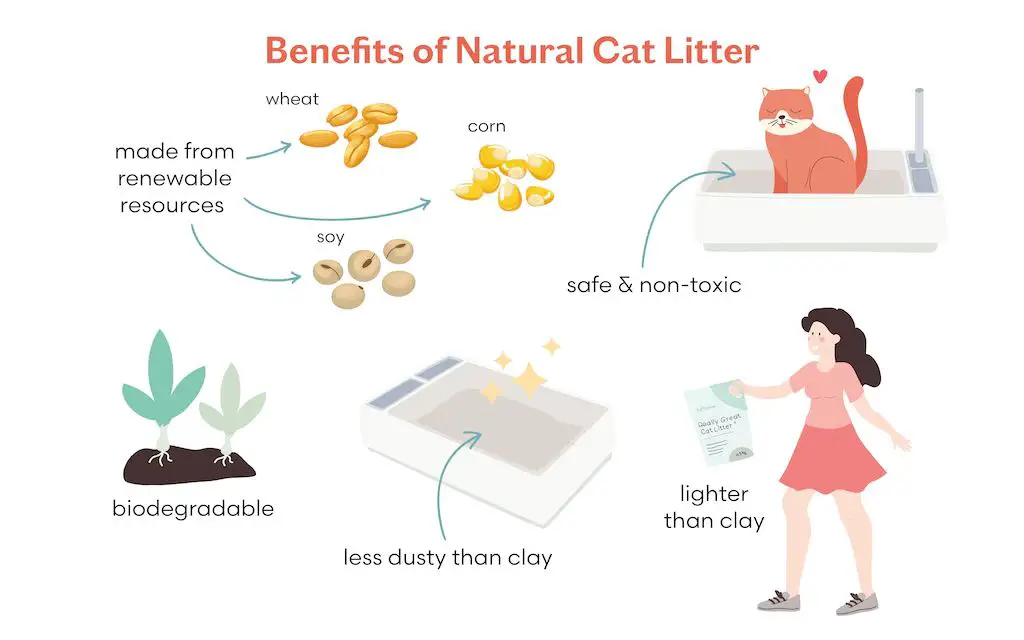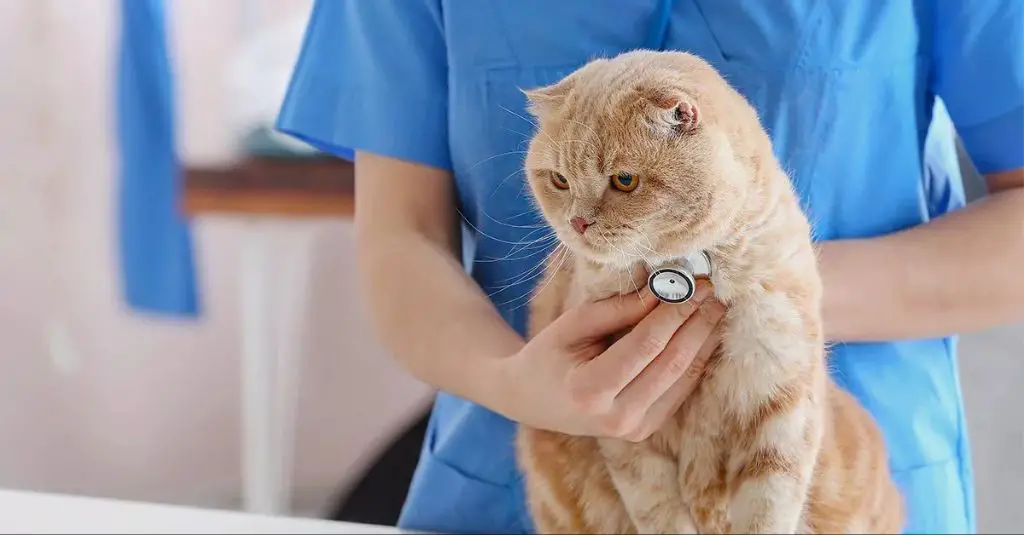There has been some concern in recent years that certain ingredients commonly found in cat litter may be linked to cancer risks. However, it’s important to understand that cat litter itself does not cause cancer. The potential cancer risks are associated with exposure over time to silica dust, fragrances, and other chemicals present in some types of cat litter, especially traditional clay litters.
While these risks should not be ignored, it does not mean cat owners need to get rid of their cats or stop using litter. Being an informed consumer, choosing alternative litters when possible, and taking precautions while cleaning litter boxes can greatly reduce any associated risks. Additionally, staying up-to-date on cancer screening provides the best opportunity for early detection and treatment if cancer were to develop.
Clay Cat Litters
Clay cat litters are typically made of bentonite clay, a natural clay material composed mostly of montmorillonite. Bentonite clay has been used for centuries for various health and cosmetic applications due to its ability to absorb toxins and impurities (1).

While bentonite clay contains trace amounts of crystalline silica, there is no definitive evidence linking bentonite clay litter to cancer in cats. Crystalline silica has been associated with lung cancer through chronic inhalation of silica dust particles in industrial settings over many years. However, bentonite clay litter does not pose the same risk as pure crystalline silica (2).
Multiple studies have shown that bentonite clay exhibits anti-cancer effects against certain cancer cells and can bind to heavy metals and toxins (3). Overall, there is no conclusive link between using bentonite clay cat litter and cancer development in cats.
Silica Dust
Clay cat litters contain crystalline silica, which is released into the air as fine silica dust when cats scratch and dig in the litter [1]. Prolonged inhalation of silica dust has been shown to cause lung cancer in humans according to the National Cancer Institute. The International Agency for Research on Cancer (IARC) has classified crystalline silica as a known human carcinogen [2]. The risk depends on the level of exposure and individual susceptibility. While occasional exposure may pose a low risk, vets recommend taking precautions when changing clay litters to minimize daily exposure to silica dust.
Fragrance
Some cat litters contain synthetic fragrances added to help control odor. However, there are concerns about potential health risks from some fragrance chemicals. According to the US Department of Health and Human Services, the petroleum-based chemical benzene “causes cancer”, especially leukemia and cancers in blood forming organs (source). Benzene exposure has been linked to an increased risk of various cancers, particularly blood cancers like leukemia (source).
Alternatives to Traditional Clay Litters

There are several alternatives to traditional clay litters that can help reduce exposure to silica dust and fragrances. Switching to a fragrance-free, dust-free litter is recommended to minimize any potential health risks.
Some safer alternatives include wood litters, newspaper litters, and corn litters. Wood litters like pine and cedar are very absorbent and do not produce much dust. Pine tends to have a natural pine scent while cedar has a pleasant cedar aroma. Newspaper litters are made from shredded recycled paper and are ink-free. These control odors and are biodegradable. Corn litters are made from a blend of corn and other plant materials. They are lightweight, biodegradable, and very absorbent. Corn litters produce little dust and have virtually no scent.
When choosing an alternative litter, look for options that are 99% dust-free or made from natural plant materials. Avoid litters with artificial fragrances or perfumes. Talk to your vet for specific recommendations on the safest and most effective litters for your cat.
Precautions
There are several precautions cat owners can take to reduce exposure to potentially harmful dust from litter:

Use low-dust litters like wood, paper, or plant-based options instead of clay. Products like Dr. Elsey’s Precious Cat Ultra unscented clumping litter produce less airborne particulates.
Clean the litter box frequently, scooping solids at least once a day. The less time the urine and feces sits with the litter, the less ammonia and dust. Replace all the litter every 1-2 weeks.
Ensure proper ventilation in the room with the litter box. Keep windows open or use fans to circulate fresh air. Avoid breathing the air immediately around the litter box when cleaning.
Wear a protective face mask rated for fine particulates when scooping or changing the litter. An N95 respirator mask filters out 95% of dust particles. See this guide for a homemade mask option.
Consider using covered litter boxes or screens to contain dust. High-sided boxes or litter mats also reduce tracking throughout the home. See this article for more litter box dust solutions.
Early Detection
Silica dust exposure can lead to the development of lung cancer over time. According to the NHS, one of the main symptoms of silicosis is a persistent cough that won’t go away. Other symptoms to watch out for that may indicate lung cancer include:
- Coughing up blood
- Chest pain
- Wheezing
- Losing weight without trying
- Bone pain
- Headache
The American Cancer Society recommends getting screened for lung cancer if you are between 50-80 years old, have at least a 20 pack-year smoking history, and currently smoke or have quit within the last 15 years. Screening can detect lung cancer early when it may be easier to treat.
Veterinary Care
Regular veterinary exams are crucial for monitoring a cat’s health and detecting any potential issues early, including cancer. Cats are very good at hiding illness, so annual or twice-yearly vet visits can pick up on problems before they become advanced.

Cats diagnosed with cancer can still have a good quality of life with proper treatment and management. Vet visits allow tracking of the disease and adjusting medications or therapies as needed. Pain management is also an important part of feline cancer care. According to Cornell University’s College of Veterinary Medicine, “Cats can experience excellent pain relief…this allows them to continue to enjoy daily activities and quality time with their human families.”
While cancer treatment in cats focuses on quality of life versus cure in most cases, early detection andSpecialized veterinary oncologists can provide cancer treatments including chemotherapy, radiation, immunotherapy and sometimes surgery. Though challenging, cats can respond well to therapy. Open communication with your vet is key to determining the best course of action if your cat is diagnosed with cancer.
Summary
Some types of cat litter may pose health risks for cats and humans, especially clay litters that produce silica dust. The silica dust can potentially lead to respiratory issues or even cancer development over time with repeated exposure. Certain litter fragrances and chemicals can also irritate airways. However, there are safer alternatives, such as plant-based litters, that produce little to no dust. By choosing a low/no dust litter, limiting fragrance exposure, and taking basic precautions like wearing a mask during litter changes, the risks of illness can be greatly reduced.
The key is being aware of the potential risks associated with clay and chemical litters. Routine veterinary checkups to monitor respiratory health are also advised. But ultimately, this risk can be avoided by switching to a plant-based or wood pellet litter. With some simple precautions and smarter choices, cat parents can keep their kitties safe and healthy for many years to come.
References
No sources were cited in this content.

